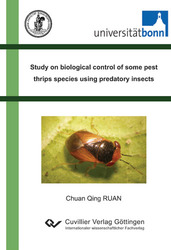| Departments | |
|---|---|
| Book Series (96) |
1378
|
| Nachhaltigkeit |
3
|
| Gesundheitswesen |
1
|
| Humanities |
2364
|
| Natural Sciences |
5406
|
| Mathematics | 229 |
| Informatics | 319 |
| Physics | 980 |
| Chemistry | 1363 |
| Geosciences | 131 |
| Human medicine | 243 |
| Stomatology | 10 |
| Veterinary medicine | 108 |
| Pharmacy | 147 |
| Biology | 835 |
| Biochemistry, molecular biology, gene technology | 121 |
| Biophysics | 25 |
| Domestic and nutritional science | 45 |
| Agricultural science | 1004 |
| Forest science | 201 |
| Horticultural science | 20 |
| Environmental research, ecology and landscape conservation | 148 |
| Engineering |
1793
|
| Common |
98
|
|
Leitlinien Unfallchirurgie
5. Auflage bestellen |
|
Advanced Search
Study on biological control of some pest thrips species using predatory insects (English shop)
Chuan Quing Ruan (Author)Preview
Table of Contents, Datei (33 KB)
Extract, Datei (180 KB)
The current research aimed to study biological control of pest thrips Frankliniella occidentalis (PERGANDE) (Thy., Thripidae), Thrips tabaci LINDEMAN (Thy., Thripidae) and Gynaikothrips ficorum (MARCHAL) (Thy., Phlaeothripidae) using predatory bug species: Geocoris ochropterus FABR. (Het., Lygaeidae), Montandoniola moraguesi (PUTON) (Het., Anthocoridae), Orius similis ZHENG (Het., Anthocoridae) and Scipinia subula HSIAO et REN (Het., Reduviidae). Firstly, the biology and prey consumption of the four predatory bug species were experimented at temperature 25oC. In further research, G. ochropterus, which displayed high prey consumption, fecundity and long longevity, was selected to study its biology and prey consumption at temperatures 18 and 30oC. After that, its prey consumption in changing prey offer, the effect of extreme temperatures, its prey preference for prey ages and species, the effect of the different nutritions, as well as its cannibalism and the intraguild predation with O. similis were determined at temperature 25oC. Finally, greenhouse experiments were conducted to confirm the efficiency of G. ochropterus for the biological control of the pest thrips.
Under laboratory conditions, the results showed that all the tested predators, except S. subula, were able to complete their life cycles with the three pest thrips species as prey at temperature 25oC. Among them, G. ochropterus was the most superior in terms of prey consumption, fecundity and longevity. Further experiments revealed that G. ochropterus displayed shorter life cycle, lower mortality, higher fecundity and daily prey consumption at temperature 30oC than at 18oC. In addition, G. ochropterus showed the adaptability to changing prey offer. It also developed well with considerably high prey consumption at extremely high constant and changing temperatures (35 and 35/25oC). Under extremely low temperature 3 and 6oC, the adults of G. ochropterus showed high tolerance. Moreover, G. ochropterus could exhibit prey preference for certain life stages of thrips, and clearly preferred pest thrips to the non-thrips prey species. Different nutritions affected the development and survival period of G. ochropterus, with the adult predators living for a considerable period of time on 10% honey emulsion. Its cannibalism and intraguild predation with O. similis occurred in the experiments, and reduced with sufficient prey availability. Under greenhouse conditions, releasing a pair of G. ochropterus adults per plant caused up to 92.1, 85.7, and 83.7% reductions in the populations of F. occidentalis, T. tabaci and G. ficorum, respectively.
| ISBN-13 (Printausgabe) | 3869551097 |
| ISBN-13 (Hard Copy) | 9783869551098 |
| ISBN-13 (eBook) | 9783736931091 |
| Final Book Format | A5 |
| Language | English |
| Page Number | 152 |
| Edition | 1 Aufl. |
| Volume | 0 |
| Publication Place | Göttingen |
| Place of Dissertation | Universität Bonn |
| Publication Date | 2009-09-29 |
| General Categorization | Dissertation |
| Departments |
Agricultural science
|
| Keywords | Biological control, Geocoris ochropterus, Frankliniella occidentalis, Thrips tabaci, Gynaikothrips ficorum |








